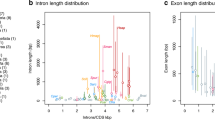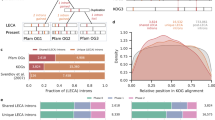Abstract
Exon-shuffling is an important mechanism accounting for the origin of many new proteins in eukaryotes. However, its role in the creation of proteins in the ancestor of prokaryotes and eukaryotes is still debatable. Excess of symmetric exons is thought to represent evidence for exon-shuffling since the exchange of exons flanked by introns of the same phase does not disrupt the reading frame of the host gene. In this report, we found that there is a significant correlation between symmetric units of shuffling and the age of protein domains. Ancient domains, present in both prokaryotes and eukaryotes, are more frequently bounded by phase 0 introns and their distribution is biased towards the central part of proteins. Modern domains are more frequently bounded by phase 1 introns and are present predominantly at the ends of proteins. We propose a model in which shuffling of ancient domains mainly flanked by phase 0 introns was important in the ancestor of eukaryotes and prokaryotes, during the creation of the central part of proteins. Shuffling of modern domains, predominantly flanked by phase 1 introns, accounted for the origin of the extremities of proteins during eukaryotic evolution.





Similar content being viewed by others
References
Altschul SF, Madden TL, Schaffer AA, Zhang J, Zhang Z, Miller W, Lipman DJ (1997) Gapped BLAST and PSI-BLAST: a new generation of protein database search programs. Nucleic Acids Res 25:3389–3402
Bateman A, Birney E, Cerruti L, Durbin R, Etwiller L, Eddy SR, Griffiths-Jones S, Howe KL, Marshall M, Sonnhammer EL (2002) The Pfam protein families database. Nucleic Acids Res 30:276–280
Blake CCF(1978) Do genes-in-piecesimplyproteins-in-pieces? Nature 273:267
Boeckmann B, Bairoch A, Apweiler R, Blatter MC, Estreicher A, Gasteiger E, Martin MJ, Michoud K, O’Donovan C, Phan I, Pilbout S, Schneider M (2003) The SWISS-PROT protein knowledgebase and its supplement TrEMBL in 2003. Nucleic Acids Res. 31:365–370
Cavalier-Smith T (1991) Intron phylogeny: a new hypothesis. Trends Genet 7:145–148
Coghlan A, Wolfe KH (2004) Origins of recently gained introns in Caenorhabditis. Natl Acad Sci USA 101:11362–11367
de Souza SJ (2003) The emergence of a synthetic theory of intron evolution. Genetica 118:117–121
de Souza SJ, Long M, Schoenbach L, Roy SW, Gilbert W (1996) Intron positions correlate with module boundaries in ancient proteins. Proc Natl Acad Sci USA 93:14632–14636
de Souza SJ, Long M, Klein RJ, Roy S, Lin S, Gilbert W (1998) Toward a resolution of the introns early/late debate: only phase zero introns are correlated with the structure of ancient proteins. Proc Natl Acad Sci USA 95:5094–5099
Doolittle WF (1978) Genes in pieces: where they ever together? Nature 272:581–582
Fedorov A, Suboch G, Bujakov M, Fedorova L (1992) Analysis of nonuniformity in intron phase distribution. Nucleic Acids Res. 20:2553–2557
Fedorov A, Cao X, Saxonov S, de Souza SJ, Roy SW, Gilbert W (2001) Intron distribution difference for 276 ancient and 131 modern genes suggests the existence of ancient introns. Proc Natl Acad Sci USA 98:13177–13182
Fedorov A, Roy S, Cao X, Gilbert W (2003) Phylogenetically older introns strongly correlate with module boundaries in ancient proteins. Genome Res. 13:1155–1157
Gilbert W (1978) Why genes in pieces? Nature 271:501
Gilbert W (1987) The exon theory of genes. Cold Spring Harb Symp Quant Biol 52:901–905
Kaessmann H, Zollner S, Nekrutenko A, Li WH (2002) Signatures of domain shuffling in the human genome. Genome Res 12:1642–1650
Liu M, Grigoriev A (2004) Protein domains correlate strongly with exons in multiple eukaryotic genomes: evidence of exon shuffling? Trends Genet 20:399–403
Long M, Rosenberg C, Gilbert W (1995) Intron phase correlations and the evolution of the intron/exon structure of genes. Proc Natl Acad Sci USA 92:12495–12499
Palmer JD, Logsdon JM Jr. (1991) The recent origins of introns. Curr Opin Genet Dev 1:470–477
Patthy L (1987) Intron-dependent evolution: preferred types of exons and introns. FEBS Lett 214:1–7
Patthy L (1991) Molecular exchange principles in proteins. Curr Opin Struct Biol 1:351–361
Patthy L (1996) Exon shuffling and other ways of module exchange. Matrix Biol 15:301–310
Patthy L (1999) Genome evolution and the evolution of exon-shuffling: review. Gene 238:103–114
Patthy L (2003) Modular assembly of genes and the evolution of new functions. Genetica 118:217–231
Pearson WR, Lipman DJ (1988) Improved tools for biological sequence comparison. Proc Nath Acad Sci USA 85:2444–2448
Qiu WG, Schisler N, Stoltzfus A (2004) The evolutionary gain of spliceosomal introns: sequence and phase preferences. Mol Biol Evol 21:1252–1263
Roy S W, (2003) Recent evidence for the exon theory of genes. Genetica 118:251–266
Roy SW, Nosaka M, de Souza SJ, Gilbert W (1999) Centripetal modules and ancient introns. Gene 238:85–91
Roy SW, Fedorov A, Gilbert W (2002) The signal of ancient introns is obscured by intron density and homolog number. Proc Natl Acad Sci USA 99:15513–15517
Sadusky T, Newman AJ, Dibb NJ (2004) Exon junction sequences as cryptic splice sites: implications for intron origin. Curr Biol 14:505–509
Sakharkar M, Passetti F, de Souza JE, Long M, de Souza SJ (2002) ExInt: an exon intron database. Nucleic Acids Res 30:191–194
Stoltzfus A, Spencer DF, Zuker M, Logsdon JM Jr., Doolittle WF (1994) Testing the exon theory of genes; the evidence from protein structure. Science 265:202–207
Stoltzfus A, Logsdon JM, Palmer JD, Jr., Doolittle WF (1997) Intron “sliding” and the diversity of intron positions. Proc Natl Acad Sci USA 94:10739–10744
Wolf YI, Kondrashov FA, Koonin EV (2000) No footprints of primordial introns in a eukaryotic genome. Trends Genet 16:333–334
Acknowledgments
The authors thank Walter Gilbert, Ricardo Brentani, and Natanja Kirschbaum-Slager for the critical reading of the manuscript. M.D.V. and N.T.S. are supported by fellowships from FAPESP.
Author information
Authors and Affiliations
Corresponding author
Rights and permissions
About this article
Cite this article
Vibranovski, M.D., Sakabe, N.J., de Oliveira, R.S. et al. Signs of Ancient and Modern Exon-Shuffling Are Correlated to the Distribution of Ancient and Modern Domains Along Proteins. J Mol Evol 61, 341–350 (2005). https://doi.org/10.1007/s00239-004-0318-y
Received:
Accepted:
Published:
Issue Date:
DOI: https://doi.org/10.1007/s00239-004-0318-y




